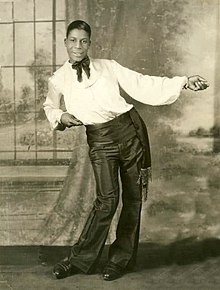Earl Snakehips Tucker
Earl "Snakehips" Tucker (August 14, 1906 in Baltimore, Maryland – May 14, 1937 in New York City) was an American dancer and entertainer. Also known as the "Human Boa Constrictor", he acquired the nickname "snakehips" via the dance he popularized in Harlem in the 1920s called the "snakehips".[1]
Career
[edit]Tucker frequented Harlem music clubs and was a regular at the Savoy Ballroom.[2] He built his reputation by exhibiting his odd style of dance, which involved a great deal of hip motion. Tucker would make it appear that he was as flexible as a snake, and eventually, the dance became his calling card. He became popular enough to eventually perform at Connie's Inn and the Cotton Club. The snakehips dates back to southern plantations before emancipation.[3]
Riding this wave of popularity, in 1930 he appeared in Benny Rubin's 16-minute short film Crazy House, a comedic introduction to residents at the fictitious "Lame Brain Sanitarium". Tucker's 2-minute dance number, performed in a shiny white shirt and shiny, baggy gold pants, displays his amazing dance innovations, his style a precursor to modern street and stage dance.[4] His name appears in the opening credits only as "Snake Hips". In 1935, Tucker appeared in a short film called Symphony in Black: A Rhapsody of Negro Life. The film was inspired by a Duke Ellington composition and included clips of Ellington composing, as well as Billie Holiday singing and Tucker doing the snakehips.[5]
References
[edit]- ^ Hazzard-Gordon, Katrina (1990). Jookin': The Rise of Social Dance Formations in African-American Culture. Temple University Press. pp. 122–123. ISBN 0-87722-613-X.
- ^ "Earl "Snakehips" Tucker", The Kennedy Center Digital Resources Library, John F. Kennedy Center for the Performing Arts, retrieved 2 August 2024
- ^ Hazzard-Gordon, Katrina (1990) Jookin': The Rise of Social Dance Formations in African-American Culture. Temple University Press. pp 122-123
- ^ Earl "Snake Lips" Tucker 1930, archived from the original on 2021-12-21, retrieved 2019-12-24
- ^ Seibert, Brian (2019-12-18). "Overlooked No More: Earl Tucker, a Dancer Known as 'Snakehips'". The New York Times. ISSN 0362-4331. Retrieved 2020-04-22.
External Links
[edit]

